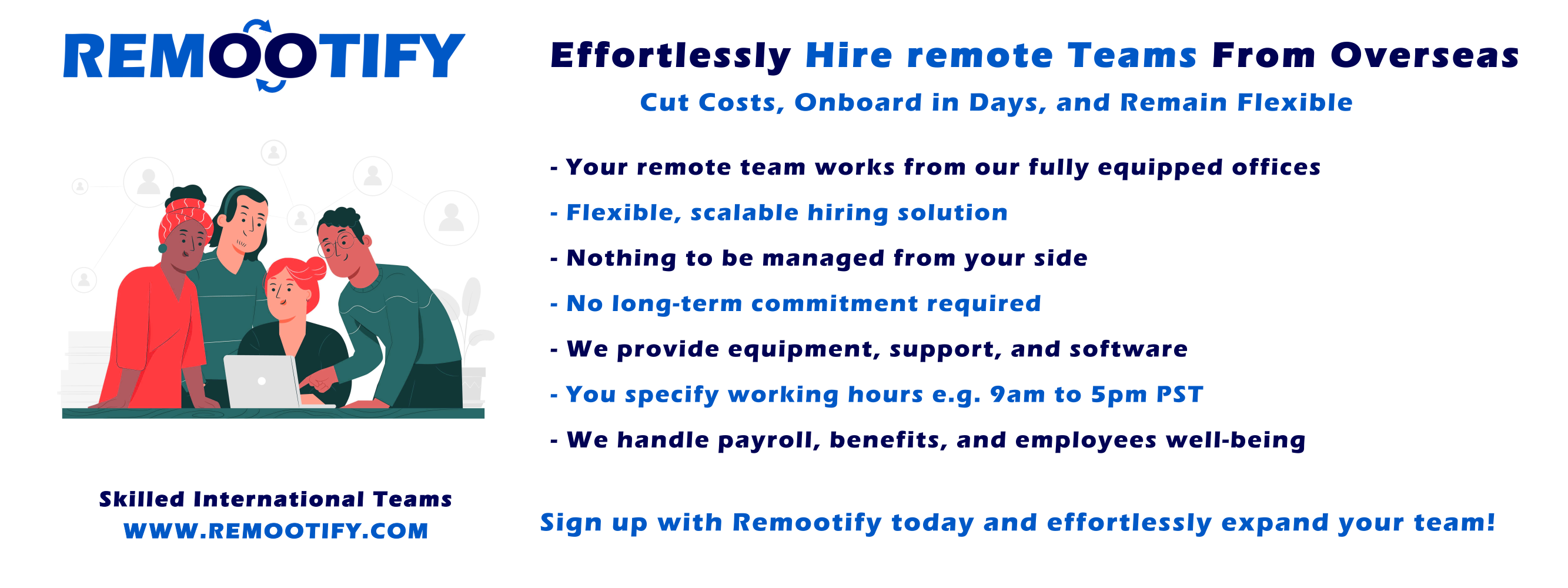Start hiring YOUR REMOTE TEAM, Today!
Enter your information below to start a discussion with one of our team members!

Are you unsure about the concept of remote-first and how it differs from being merely remote-friendly? Recognize that remote-first is an organizational model where working remotely isn’t just an option, but a primary preference.
This article will illuminate what defines a remote-first culture, its benefits, and practical tips on establishing this culture within your organization. Let’s navigate the evolving waters of corporate cultures together!
Key Takeaways
- Remote – first culture prioritizes remote work as the main way of working, offering flexibility and freedom for employees to work from anywhere.
- Remote – first companies foster inclusivity and collaboration, providing the necessary tools for effective remote work.
- Benefits of a remote – first culture include access to top talent, cost reduction, streamlined work processes, increased productivity and loyalty among employees, reduced carbon footprint, and improved lifestyle.
- To create a remote – first culture, businesses should establish processes that support remote work, define communication and collaboration tools, and implement efficient systems for hiring and onboarding remote workers.
Understanding Remote-First Culture
Remote-first culture refers to a work environment where remote work is the primary option and default way of working, as opposed to being a secondary or occasional arrangement like in remote-friendly cultures.
Definition of remote-first
Remote-first is a way of work. In this setup, people do not need to go to an office every day. Companies see remote work as their main style of work. It is more than just letting workers stay at home sometimes.
This kind of setup brings change to the company’s culture and tools for work. Workers feel valued in a remote-first firm because they can do their tasks from anywhere.
Remote-first vs. remote-friendly
Understanding the difference between remote-first and remote-friendly is essential for businesses planning to implement or improve their remote work structure.
| Remote-First | Remote-Friendly | |
|---|---|---|
| Definition | A remote-first company is an organization that prioritizes remote work as the default way of working, thereby treating all work arrangements as equal whether they are remote or office-based. | A remote-friendly company, on the other hand, allows remote work but still sees physical presence in the office as the primary mode of operation. |
| Culture | Remote-first companies foster a culture of inclusivity and collaboration for remote employees. They are intentional about the tools and strategies used to promote remote work. | Remote-friendly companies may allow remote work, but they usually lack the full-fledged support and resources necessary for effective remote working. |
| Workplace | In a remote-first company, all employees are not required to come to a centralized physical office. Team members have the flexibility to work from anywhere. | In a remote-friendly company, remote work is a benefit, not the norm. Employees may have the option to work remotely, but the office remains the central hub for work activities. |
| Transition | Shifting to a remote-first structure takes intentional planning and strategy. Companies must implement best practices for remote collaboration and communication. | For remote-friendly companies, the shift to remote work may not be as comprehensive. These companies may not have systems in place for effective remote hiring and onboarding. |
Benefits of Remote-First Culture
Remote-first culture offers numerous benefits, including access to top talent, cost reduction, streamlined work processes, increased employee productivity and loyalty, reduced carbon footprint, and improved lifestyle.
1-Access to top talent
Remote-first companies have a significant advantage when it comes to accessing top talent. By embracing remote work as the primary option, these companies are not constrained by geographical limitations.
They can hire employees from anywhere in the world, allowing them to tap into a global pool of highly skilled professionals. This expanded talent pool gives remote-first companies a competitive edge and enables them to bring in experts who may not be available or interested in traditional office-based arrangements.
As a result, remote-first organizations have the opportunity to assemble diverse and specialized teams that can drive innovation and success.
2-Cost reduction
One of the significant benefits of adopting a remote-first culture is the potential for cost reduction. By embracing remote work as the primary option, businesses can save on various expenses associated with maintaining physical office spaces, such as rent, utilities, and equipment.
Additionally, remote-first companies are not limited to hiring employees in specific geographical locations, allowing them to access talent from around the world without incurring relocation costs.
This shift towards remote work can lead to significant savings for businesses while still maintaining productivity and efficiency.
3-Streamlined work processes
Remote-first companies prioritize streamlined work processes to ensure efficient collaboration and productivity. By leveraging digital tools and technology, remote teams can seamlessly communicate, share documents, and track project progress.
This streamlining of work processes allows for faster decision-making, eliminates unnecessary bureaucracy, and reduces time wasted on administrative tasks. With clear communication channels and defined workflows in place, remote employees can focus on their core responsibilities without being bogged down by office distractions.
Streamlined work processes also contribute to increased employee satisfaction and motivation as they can complete tasks more efficiently and have a better work-life balance.
4-Increased employee productivity & loyalty
Remote-first culture can lead to increased employee productivity and loyalty. When employees have the flexibility to work from anywhere, they are more likely to feel empowered and motivated.
This autonomy can result in higher productivity as employees are able to create a work environment that suits them best. Additionally, remote-first companies often prioritize the well-being and work-life balance of their employees, leading to greater job satisfaction and loyalty.
A study conducted by Owl Labs found that remote workers were 13% more likely to say they would stay at their current job for the next five years compared to on-site workers. By embracing a remote-first approach, businesses can create an environment where employees thrive and remain committed for the long term.
5-Reduced carbon footprint
A remote-first culture can significantly contribute to reducing your company’s carbon footprint. By allowing employees to work remotely, you eliminate the need for commuting and reduce the emissions associated with daily travel.
This shift towards remote work also reduces the need for large office spaces, resulting in decreased energy consumption and a smaller environmental impact. Additionally, a remote-first approach encourages paperless communication and digital collaboration tools, further minimizing waste.
By embracing remote work as part of your organizational strategy, you can make a positive impact on the environment while still maintaining productivity and business growth.
6-Improved lifestyle
A remote-first culture can greatly improve the lifestyle of employees. With the flexibility to work from anywhere, they have more control over their schedules and can achieve a better work-life balance.
This means they can spend more time with family and pursue personal interests without sacrificing productivity. Additionally, remote work eliminates long commutes and allows employees to create a comfortable workspace that suits their needs.
It also promotes health and well-being by reducing stress levels associated with traditional office settings. Remote-first companies prioritize employee happiness and satisfaction, leading to increased job satisfaction and loyalty among team members.
How to Create a Remote-First Culture
Establish processes to support remote work, define tools for communication and collaboration, and implement efficient systems for remote hiring and onboarding.
1-Establishing processes to support remote work
To create a remote-first culture in your business, it’s important to establish processes that support remote work. Here are some key steps to follow:
- Develop clear remote work policies: Create guidelines and expectations around remote work, including working hours, communication methods, and accountability.
- Set up a virtual workspace: Use digital tools and platforms to create a virtual office space where employees can collaborate, share documents, and stay connected.
- Implement effective communication channels: Choose communication tools that facilitate real-time conversations, such as video conferencing and instant messaging platforms.
- Provide access to necessary resources: Ensure that remote employees have access to the tools, software, and equipment they need to perform their jobs effectively.
- Establish regular check-ins and feedback mechanisms: Schedule regular team meetings or one-on-one check-ins to keep everyone aligned on goals, address questions or concerns, and provide feedback.
- Foster a sense of belonging: Create opportunities for remote employees to connect with each other through virtual social events or team-building activities.
- Encourage self-care and work-life balance: Promote healthy habits by encouraging employees to take breaks, set boundaries between work and personal life, and prioritize their well-being.
- Support professional development: Offer resources for skill-building or training programs that can help remote employees grow professionally even when they are not physically present in the office.
2-Defining tools for communication and collaboration
To create a remote-first culture in your company, it is important to define the tools for communication and collaboration. Here are some key tools to consider:
- Video Conferencing: Use platforms like Zoom or Microsoft Teams for virtual meetings and face-to-face communication with remote team members.
- Instant Messaging: Utilize tools like Slack or Microsoft Teams for quick and real-time communication between team members.
- Project Management Tools: Implement project management software such as Trello or Asana to track tasks, assign responsibilities, and monitor progress.
- File Sharing Systems: Set up cloud-based file sharing systems like Google Drive or Dropbox to ensure easy access and seamless collaboration on documents, presentations, and other files.
- Virtual Whiteboards: Explore digital whiteboard tools like Miro or Mural for visual collaboration, brainstorming sessions, and idea sharing.
- Document Collaboration: Enable collaboration on documents by using tools like Google Docs or Microsoft Word Online, allowing multiple team members to edit and comment simultaneously.
- Shared Calendars: Use shared calendar apps such as Google Calendar or Microsoft Outlook to schedule meetings, set reminders, and coordinate availability across different time zones.
- Task Tracking Platforms: Consider using task tracking tools like Jira or Monday.com to efficiently manage projects, assign tasks, track progress, and ensure accountability.
3-Implementing efficient systems for remote hiring and onboarding
To successfully implement remote hiring and onboarding processes in your company, follow these steps:
- Develop a streamlined remote hiring process that includes job postings, interviews, and candidate evaluations conducted virtually.
- Utilize digital platforms and tools for conducting interviews remotely, such as video conferencing software or online assessment platforms.
- Provide clear guidelines and expectations for remote onboarding, including access to necessary equipment, software, and resources.
- Implement virtual training programs and orientation sessions to help new hires adapt to their roles and the remote work environment.
- Assign a mentor or buddy to new hires for ongoing support and guidance during their initial weeks with the company.
- Maintain regular communication with remote employees during the onboarding process to address any questions or concerns they may have.
- Foster a sense of community among remote employees by organizing virtual team – building activities or social events.
- Ensure that all necessary documentation and paperwork can be completed electronically to ease the administrative burden of remote hiring and onboarding processes.
Conclusion
In conclusion, remote-first is an organizational approach that prioritizes remote work as the default way of working. It goes beyond just being remote-friendly by integrating remote work into the company’s core operations.
This culture brings numerous benefits including access to top talent, cost reduction, streamlined processes, increased productivity and loyalty, reduced carbon footprint, and improved lifestyle for employees.
To create a remote-first culture, businesses should establish supportive processes, define communication tools, and implement efficient systems for hiring and onboarding remote workers.
By embracing these practices, companies can empower their teams to thrive in a virtual workplace.
FAQs
1. What does “remote first” mean?
“Remote first” refers to a work approach that prioritizes remote work as the default option for employees, allowing them to work from anywhere rather than being tied to a physical office location.
2. What is the difference between “remote first” and “remote friendly”?
While both terms involve accommodating remote work, “remote first” means that remote work is the primary mode of operation, while “remote friendly” means a company supports and allows occasional remote work but still emphasizes in-person collaboration.
3. What are the benefits of adopting a remote-first approach?
Adopting a remote-first approach provides benefits such as increased flexibility for employees, access to global talent pool, reduced overhead costs for office space, and improved work-life balance.
4. How can I create a remote-first culture in my organization?
To create a remote-first culture, you can establish clear communication channels, promote trust among team members through regular check-ins and feedback sessions, provide necessary resources for effective virtual collaboration, and foster a sense of belonging through virtual team-building activities.





